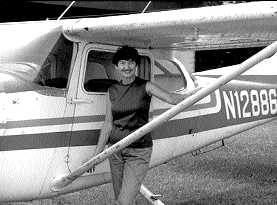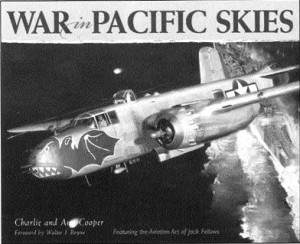By Karen Di Piazza
Readers of the works of Ann Lewis Cooper will be happy to know that the author has a new book due out soon. In May, Motorbooks International will release “War in Pacific Skies, Featuring the Aviation Art of Jack Fellows,” which Cooper wrote in collaboration with her husband, Maj. Gen. Charles S. Cooper III, USAF (ret.).
With the book, readers can jump into the cockpit of America’s famous warbirds, such as the P-38, F-4U Corsair, B-25 and B-29. In this fusion of art and history, the Coopers have portrayed in accurate detail, complete with the personal insights of combatants, many of the famous engagements that took place during World War II. Never before published photographs and full-color maps are included.
Three of Cooper’s published books are a fuse of art and history, while the other four are in-depth, behind-the-scenes interviews with some of the century’s most fascinating female flyers.
“Frankly, there’s more to life than Amelia Earhart,” says Cooper, who is well aware that many aviators aren’t as well known as that aviatrix.
“Rising Above It, Edna Gardner Whyte” and “Weaving the Winds”
In 1991, Crown Publishing put out “Rising Above It, Edna Gardner Whyte,” by Edna Gardner Whyte with Ann Cooper. This autobiographical account demonstrates the bulldog determination of Whyte, who became an air racer and won her first race in 1933. She received more than 100 trophies, and became a flight instructor and aviation entrepreneur who wouldn’t let male chauvinism get in her way.
Whyte, born in 1902, flew in an era when women weren’t allowed to vote; going against what “women were allowed to do,” she was discriminated against when she went for her pilot’s license in 1931. The government inspector told her he had never licensed a woman and didn’t want to start.
“By the time I interviewed Whyte, she was 84; she was still full of herself, still flying, but still in demand,” she said. “I came to the conclusion that she ‘made’ some of her own discrimination. She was an in-your-face type of personality. She was quick to damn men and quick to become angry, yet men gave her the opportunities she had. Edna got where she was by true grit; she served in the military as a Navy nurse, and then did the same for the Army.”
Denied the chance to fly for the military, Whyte taught military pilots. Commercial airline companies refused to hire her; she turned around with her “I’ll show you attitude” and trained hundreds of students for their cockpits.
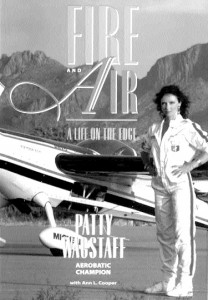
“Fire and Air, A Life on the Edge,” chronicles the life of Patty Wagstaff, the first women in the U.S. to capture the coveted title of National Aerobatic Champion.
When Texas bankers refused to loan her money to start her own airport, true grit got her what she wanted; she borrowed money from friends and “blazed a runway across a cotton field,” Cooper said.
Whyte’s name is engraved in history. The Texas Women’s Hall of Fame inducted her for “business acuity,” and the Charles Lindbergh Lifetime Achievement Award was bestowed upon her. She served as the international president of the Ninety-Nines and logged more than 30,000 hours of flight before her death in 1993.
Cooper points out the contrast of Whyte’s cantankerous personality against other “fabulous flying babes.”
“Weaving the Winds,” due out this year, focuses on Emily Howell Warner, who, in 1973, became the first woman to fly for a U.S. scheduled air line carrier (Frontier) as a pilot (in modern times).
“She was one of the crew; she fit in; she didn’t make a lot of belligerent demands,” she said. “I think you have to be somewhat accommodating; it goes a lot further. Having a chip on your shoulder isn’t going to get you where you want to be.”
“On The Wing, Jessie Woods and the Flying Aces Air Circus”
Accommodating is a poignant concept in “On The Wing, Jessie Woods and the Flying Aces Air Circus” (Blackhawk Publishing, 1993).
At age 19, Jessie E. Schultz thought life was on course. She was attending Washington State University; she was an honor student and athlete, and played the violin in a 100-piece symphony orchestra. Then, during her summer break in Ulysses, Kansas, she met Jimmie Wood. In 1929, she eloped with the daredevil pilot of a Swallow biplane who was 11 years her senior.
“Jessie was mad about him; she risked her life to please him, and yielded to his will,” said Cooper.
Together, they founded the Flying Aces Air Circus. Coaxed, Jessie became a wing-walker. On her first try, the windblast nearly sent her to the ground when her husband almost lost control of the aircraft. He also talked her into dangling from rope ladders. In addition, she became an excellent pilot, stunted planes and amazed the crowd with her parachuting abilities.
But, she lived in fear and hunger, slept without a bed and had few articles of clothing. Flying gypsies and motorcycle daredevils surrounded her rowdy existence, with a lifestyle that brought thrills, but also danger and abuse, until the circus closed in 1938.
“Aviation was changing; it was the era of Lindbergh, Earhart and intrepid airmail pilots,” Cooper explained. “Barnstormers and wing-walkers gave way to Civil Aeronautics Authority bureaucrats and transcontinental airliners. As World War II loomed on the horizon, the Woods got a chance to operate a pilot training program in Rock Hill, South Carolina.”
However, Jimmie came down with a mysterious illness, and died in 1959. Jessie joined the Civil Air Patrol, was an organizer of the Ninety-Nines, was named Washington’s Pilot of the Year and received induction into the OX-5 Aviation Pioneer Hall of Fame.
The Flying Aces Air Circus was the longest of its kind in the U.S., with more than 400 performances.
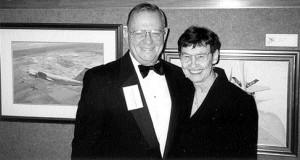
Maj. Gen. Charles Cooper and Ann Lewis Cooper collaborated on “War in Pacific Skies, Featuring the Aviation Art of Jack Fellows,” “Tuskegee’s Heroes, Featuring the Aviation Art of Roy La Grone” and “How to Draw Aircraft Like a Pro.”
“The Flying Aces made money and helped to popularize aviation,” she said. “They also demonstrated, tested and perfected the latest planes of America’s struggling aircraft companies such as Cessna, Beech and Stearman; they helped aviation move forward. America’s World War II flyers owed these freewheeling pilots a thank you!”
“Fire and Air, A Life On the Edge”
With Patty Wagstaff, Cooper wrote “Fire and Air, A Life On the Edge,” published by Chicago Review Press in 1995. The book tells the story of the pioneer aerobatic pilot who was the first woman in the U.S. to capture the coveted title of National Aerobatic Champion.
“Patty wasn’t raised to succeed at anything,” says Cooper. “Her alcoholic, abusive parents sent her to an endless series of girls schools in hopes of squelching her ‘wild side.’ As a runaway and adventurer, trouble seemed to be her destiny. Then, in Alaska, she met the man who encouraged her to believe that she could achieve anything that she was determined to do. He taught her how to fly.
“Patty is a woman with an inner fire, a drive that could have meant her destruction, but given a focus and a goal, catapulted her to the pinnacle of success,” said Cooper.
Today, Wagstaff is a favorite airshow and Hollywood stunt pilot. Her famous aircraft, “Extra 260,” is displayed in the Pioneer Gallery of the Smithsonian’s National Air & Space Museum. It sits side-by-side with aircraft flown by Amelia Earhart, Charles and Anne Morrow Lindbergh and General James “Jimmy” Doolittle.
“How High She Flies, WASP of WWII, Horsewoman, Artist and Teacher”
“How High She Flies, WASP of WWII, Horsewoman, Artist and Teacher,” by Cooper with Dorothy Swain Lewis (Aviatrix Publishing, 1998), tells of a woman who Cooper says was “born to excel, in her every achievement.”
“Dot was born into a musical and intellectual family in Asheville, North Carolina,” Cooper said.
“Her mother was a concert pianist, her uncle received a Pulitzer Prize for his musical compositions, her father was a learned and respected judge and her brother became a state senator,” Cooper said.
Lewis unveiled her fourth bronze sculpture of a Women Airforce Service Pilot at the U.S. Air Force Academy in 1997; the artist was honoring her sister pilots of World War II, depicting the life that they all devoted in service to our country.

“Tuskegee’s Heroes, Featuring the Aviation Art of Roy La Grone,” portrays what life was like for the Tuskegee Airmen.
“Lewis served as a WASP, teaching flying to other WASP and taking to the cockpits of the P-39 and P-40 fighters and to the B-26 Martin Marauder,” Cooper said. “Her sculptures commemorate the bravery, patriotism and courage of the women who were our country’s first female military pilots.”
The quintessential teacher, Lewis instructed Navy pilots for WWII and many students after the war. She also taught horsemanship. “Model Hunter,” a mare that she trained, took best in show at the New York City National Horse Show. Lewis also taught science and art at The Orme School in Arizona and Idyllwild School of Music and the Arts in California. In addition, she created the ongoing annual Fine Arts Festival at Orme in 1968.
Her bronze statures grace Avenger Field, Sweetwater, Texas; The Confederate Air Force Museum, Midland, Texas; the U.S. Air Force Museum and the Honor Court of the U.S. Air Force Academy.
“Tuskegee’s Heroes, Featuring the Aviation Art of Roy La Grone”
In “Tuskegee’s Heroes, Featuring the Aviation Art of Roy La Grone,” Motorbooks, 1995, the Coopers portray what life was like for the first black pilots and personnel that took to the air for the U.S. Army Air Corp.
Roy La Grone, one of the Tuskegee Airmen, has beautifully illustrated the pages with art from the heart.
“The Tuskegee experiment was bound for failure,” said Cooper. “Leadership of the U.S. Army Air Corps believed that it was impossible for a black man to learn how to fly, so they fought against the training and assignment to combat of black aviators. Even the early battles fought in the Mediterranean by the P-40 Warhawks flown by the Tuskegee Airmen were maligned by Air Corps leadership in the field and in Washington, D.C.
“People need to know about these courageous, segregated fliers and support personnel who served so valiantly during the war in North Africa, Sicily, Italy and throughout war-torn Europe. They contributed significantly in the allied victory over Hitler’s Third Reich.”
“How to Draw Aircraft Like a Pro”
“How to Draw Aircraft Like a Pro” is a collaboration between the Coopers and Andrew C. Whyte, former president of the American Society of Aviation Artists, and 30 renowned U.S. aviation artists.
In the book, published by Motorbooks in 2001, readers are shown how to turn aviation doodles into masterpieces. The “how-to” starts with basic aviation art tools and equipment.
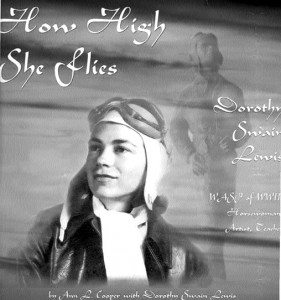
Cooper wrote “How High She Flies, WASP of WWII, Horsewoman, Artist and Teacher” with Dorothy Swain Lewis, who besides being a WASP, trained other WASP to fly as well as Navy pilots, taught horsemanship and was a sculptor.
Ann Cooper
Cooper, who has also written over 700 magazine articles, not all aviation-related, is also an aviator. She is a certified flight instructor and instrument rated, with 2,000 flight hours in single-engine land aircraft. She has also served as a designated safety advisor and written test administrator for the Federal Aviation Administration.
Born in Baldwin, N.Y., the youngest of three children, Cooper says that she had a “brainy” family.
She inherited a love of art from her stay-at-home mom, who had once been an art/music teacher. Her father was a chemist.
“My brother received his Ph.D. from the University of Michigan, altogether skipping a master’s,” she said. “My sister graduated from Vassar College in the accelerated program in three years and went on to a get her master’s.”
Cooper grew up in the kind of household where you could walk in and expect things to “look perfect.”
“My parents entertained all of the time and I guess it was a formal environment,” she said. “On the other hand, my mother was loving, nurturing and she sewed quite well; she made at least 60 costumes for my drama department. There was a bit of theatrics going on as well; my father a ham, tapped danced with me on a regular basis. Aside from the drama and laughs, education was a dominant presence.”
Cooper said it was never a question of “if” she would go to college, but where.
After graduating from high school, she left New York to attend the University of Colorado, mostly because she was “trying to be different.”
“I wanted to set myself apart, be different from my brother and sister,” she said. “So, I headed west for college.”
Besides separating her from the family norm, it introduced her to a different kind of culture. She once dreamed of becoming a meteorologist, but found out that she was “lousy” at math. She would later transfer to a college in Connecticut and earn a degree in sociology.
Cooper’s introduction to aviation was through her marriage to Storrs Warinner, an Air Force officer who was a navigator and pilot. One evening, she attended a cocktail party with her husband and overheard one of the lieutenant’s wives announce that she had received her private pilots license. Cooper decided that she would do the same.
By that time, she had three young children at home to take care of—Linda, her oldest, Beth, who Cooper would later teach to fly, and John, the youngest.

“Rising Above It, Edna Gardner Whyte,” tells the story of Edna Gardner Whyte, air racer, flight instructor and past international president of the Ninety-Nines.
She was hesitant at first to take lessons; this would be her second time to sit inside of the cockpit; her first experience was anything but pleasurable.
“During my husband’s pilot training at Vance Air Force Base in Oklahoma, I had the rare opportunity to accompany one of his flight instructors for a ride; oh man, it sure was!” she recalls. “I had never been inside of a light plane; he scared the heck out of me with stalls and turns. I just wanted out.”
In May 1969, she began taking flying lessons at Southern Oregon Aviation on Kingsley Field. By August of that same year, she earned her license. Cooper’s first solo experience took place in a Cessna 150, and because her husband played a joke on her, she’ll never forget it.
“Without warning, one day my instructor told me to take off,” she said. “I did and I saw my husband standing at the end of the 10,500-foot runway. Before I knew it, I was in a downwind and made radio contact with the tower. Suddenly, I heard a child’s voice say, ‘Six-four-Juliet…touch and go.’ It was my daughter! The second pass around I heard my other daughter; my heart was in my throat. My flight instructor was furious over my husband’s shenanigans.”
Cooper realized that pilots were a special breed. They had to make split-second decisions and have extraordinary stamina and a hunger for knowledge, and they had a zest for life. Her life became consumed by aviation from that point on.
Cooper moved 21 times within 21 years during her first marriage; her flight training took place all over the U.S. She received her commercial rating, ground instructor advanced ratings and glider rating, as well as becoming a ground school flight instructor. Following that, she became a full-fledged flight instructor.
The course of Cooper’s life landed her back in Oregon skies with new horizons and familiar friends.
The Coopers divorced after 21 years of marriage. She lived in El Paso for a short time and worked as a chief ground flight instructor. In 1976, when her father died, she took her three young children and two horses and drove her truck back to Oregon. She returned to Southern Oregon Aviation, this time as their flight instructor.
She worked a second job during the evening at Oregon Institute of
Technology, where she taught ground school courses. Unfortunately, circumstances would again alter her life. Her mother had suffered a severe stroke in 1982, and she required 24-hour care. By 1988, Cooper found a new career.
“Flying came to an end,” she said. “My mother needed me, so I moved her into my home. That’s when I got the idea of writing for a living. I lived in a small town and found that people were willing to talk with me and share their experiences.”
At first, she wrote articles about animals—horses, cats and birds, but she would soon find a way to use her aviation knowledge. The small town of Klamath Falls provided just the interview she needed.
Larry Burton, an experimental kit builder, winched a log out of the Oregon Cascades. Out of that log came a kit plane that he allowed Cooper to name. She chose Celerity.

“On The Wing, Jessie Woods and the Flying Aces Air Circus,” tells the story of Jessie and Jimmie Wood, founders of the longest running “circus” of its kind in the U.S.
“The kit is still in production today, but back then everyone thought if you logged wood out of the Cascades, it would turn out looking like something from the ‘Flintstones,” Cooper said. “I flew in it, photographed it during all phases of production, interviewed him and submitted my first aviation story.”
As for her collaborator on some of her books, the author married Charles Cooper, a long-time friend, long before she became an aviation novelist.
They were married 14 years ago.
The Coopers live in Ohio and when they’re not writing, they spend time with their 15 grandchildren.











